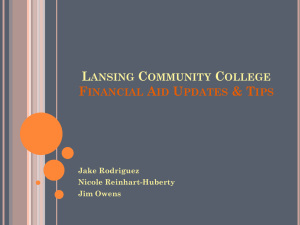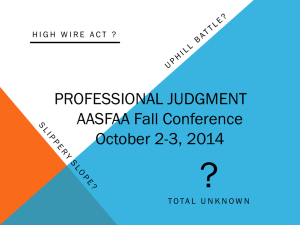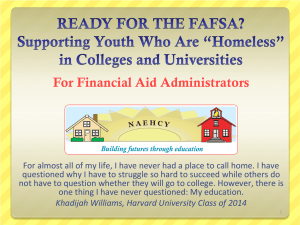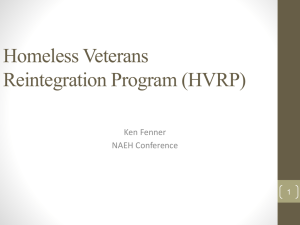PowerPoint
advertisement
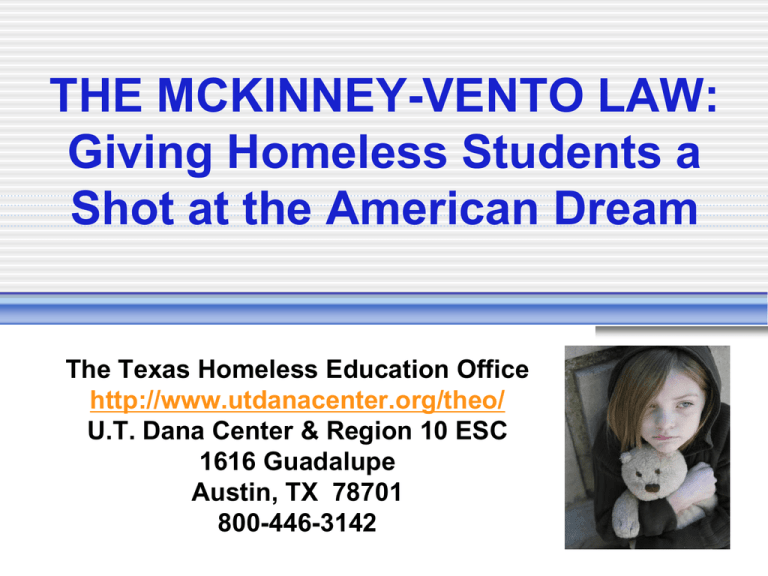
THE MCKINNEY-VENTO LAW: Giving Homeless Students a Shot at the American Dream The Texas Homeless Education Office http://www.utdanacenter.org/theo/ U.T. Dana Center & Region 10 ESC 1616 Guadalupe Austin, TX 78701 800-446-3142 1 OUR AGENDA TODAY • Background of the McKinney-Vento Law: the Federal NCLB law and the state Texas Education Code • Defining Homelessness • School Personnel Responsibilities: local liaison and school administrators • School of Origin, Transportation Issues, Dispute Resolution 2 FINDING ANSWERS • CALL THE TEXAS HOMELESS EDUCATION OFFICE: 1-800-446-3142 1-512-475-9715 VICKY DILL • EMAIL VICKYDILL@AUSTIN.UTEXAS.EDU • TEA information at http://www.tea.state.tx.us/index4.aspx?id=21 47503685 3 Poverty in Texas • Low Wages and Rising Rents • Scarce Supportive Housing • Families without Health Care 4 Students Coded Homeless 2012 • 2010-2011 85,155 • 2011-2012 94,624 • 2012-2013 100,635-102,579 5 Why Are So Many Homeless? • While it's true that Texas is responsible for 40% of the jobs added in the U.S. over the past two years, its poverty rate also grew faster than the national average in 2010. 6 Why Are Children Homeless? • Some 18.4% of Texans were impoverished in 2010, up from 17.3% a year earlier, according to Census Bureau data released in 2012. • The national average is 15.1%. • Texas leads the nation in the number of people who have no health insurance. 7 Texas: 6th Poorest State in Nation • Texas has the 6th highest poverty rate in the nation; one in every 6 Texans or 4.4 million Texans live in poverty. • While the unemployment rate is low, many Texans need two or three lowpaying jobs to make ends meet. 8 Texas: High Poverty, Poor Health Care • In the United States, about 1.5 million children in grades K-12 are homeless; • In Texas alone, no fewer than 103,000 students are homeless. Under-identification is widespread; • Child poverty in Texas increases every year: 26.2 percent of Texas children are currently living in poverty. • To give you a better idea, that's more than one-in four children. 9 Texas: High Poverty, Poor Health Care • In the United States, about 1.5 million children in grades K-12 are homeless; • Child poverty in Texas increases every year: 26.2 percent of Texas children are currently living in poverty. • To give you a better idea, that's more than one-in four children. 10 Decline of the Middle Class In 2008, there were an estimated 13.9 million households comprised of two or more families. By 2010, the number of multifamily households increased to 15.5 million, accounting for 13.2 percent of all households. The Effects of Recession on Household Composition: “Doubling Up” and Economic Well-Being. Laryssa Mykyta and Suzanne Macartney, U.S. Census Bureau SEHSD Working Paper Number 2011-4 (2011). 11 BACKGROUND Background of the McKinney-Vento Law: the Federal NCLB law and the State of Texas Education Code 12 WHAT IS MCKINNEY-VENTO? This law is a result of bipartisan legislation in the 1980’s. After the death of its chief Republican sponsor, Representative Stewart B. McKinney of Connecticut, the act was renamed the Stewart B. McKinney Homeless Assistance Act. President Ronald Reagan signed it into law on July 22, 1987. At the time it was enacted, 50% of all homeless students dropped out of school. 13 Is This a New Law? On October 30, 2000, President William Clinton renamed the legislation, “The McKinney-Vento Homeless Assistance Act” upon the death of Representative Bruce Vento, a leading supporter of the act since its original passage in 1987. Reauthorized many times, it is currently part of NCLB Part C. 14 REQUIREMENTS OF THE LAW • Every state by federal law must have a McKinney-Vento State Coordinator’s Office (THEO in Texas). This office oversees statewide training. • Every district must, by law, have a McKinney-Vento Homeless Liaison to ensure the rights of homeless students to enroll in school. 15 MCKINNEY-VENTO AT A GLANCE • THIS HANDOUT SUMMARIZES THE KEY PROVISIONS OF THE M-V ACT: Definitions of homelessness The goal of the Act: academic success School selection/transportation Enrollment (without documentation) Dispute Resolution Local liaisons, segregation, subgrants 16 DISTRICT ADMINISTRATORS’ ROLE “WHAT ADMINISTRATORS SHOULD KNOW” STEREOTYPES AND STIGMAS EDUCATIONAL STABILITY IMMEDIATE ACCESS: TRAINING FRONT OFFICE STAFF ON AN ONGOING BASIS THE HOMELESS LIAISON USE OF TITLE I PART A 17 DEFINING “HOMELESS” • The Housing and Urban Development agency (HUD) has a different definition of “homeless” than the TEA. It does not include the doubled-up category. • The Hearth Act of 2009 mandates that districts and HUD work together to ensure that families are identified. Be aware that there may be other families who are homeless than those identified by HUD. 18 Decline of the Middle Class Everyone is talking about the wealth gap. In Texas, it is severe. In 2012, there are about 70,000 people living “doubled-up” in Texas. The Effects of Recession on Household Composition: “Doubling Up” and Economic Well-Being. Laryssa Mykyta and Suzanne Macartney, U.S. Census Bureau SEHSD Working Paper Number 2011-4 (2011). 19 WHO IS HOMELESS? Children and youth who lack a fixed, regular, and adequate nighttime residence: Sharing the housing of others due to loss of housing, economic hardship, or similar reason Living in motels, hotels, trailer parks, camping grounds due to lack of adequate alternative accommodations Living in emergency or transitional shelters THINK OF THE ACRONYM “FAR” 20 WHO IS HOMELESS? Awaiting foster care placement Living in a public or private place not designed for humans to live Living in cars, parks, abandoned buildings, substandard housing, bus or train stations, etc. Migratory children living in above circumstances (Definitions of “fixed, adequate, regular” in “Determining Rights”) 21 “Trailer Trials” It’s not easy to tell what a homeless student looks like, yet living doubled up takes its toll: 22 WHO IS RESPONSIBLE? • Final identification is the responsibility of the district liaison; however the process occurs, it must be thorough and auditable. Everyone should help. • The more comprehensive the efforts to identify students and families, the more likely it is that most McKinney-Vento families will succeed. 23 LOCAL EDUCATION AGENCY LIAISONS • KEY PROVISIONS • STRATEGIES FOR IMPLEMENTATION 24 LOCAL LIAISON DUTIES • Identify unaccompanied children and youth through school and community outreach efforts. • Help students and families select and enroll in school. • Inform eligible students of their rights to transportation to the school of origin and assist with arranging transportation. 25 Parent Notification The McKinney-Vento Act requires public notice of educational rights of children and youth experiencing homelessness be disseminated in every school district at every campus – and wherever services are accessed. PEIMS INDICATOR 1. A determination must be made regarding the housing status for EACH student in every LEA. One of five possible living situations must also be identified for those students who are identified as "homeless." 2. A determination must be made regarding the unaccompanied youth status for EACH student that is identified as "homeless." 27 PEIMS INDICATOR • Complete information is available at http://www.utdanacenter.org/theo/news/ind ex.php • Effective with the 2012-13 school year, PEIMS has incorporated two new indicators for students 28 PEIMS HOMELESS INDICATOR • ALSO AVAILABLE: PEIMS HOMELESS STATUS INDICATOR INSTRUCTIONS http://www.utdanacenter.org/theo/resources/fac tsheets.php#PEIMSindicators PEIMS UNACCOMPANIED YOUTH STATUS TEMPLATE http://www.utdanacenter.org/theo/resources/fac tsheets.php#PEIMSindicators 29 PEIMS HL STATUS FAQ • GO TO http://www.utdanacenter.org/theo/resource s/factsheets.php#PEIMSindicators 30 Are Your Numbers Reasonable? About 10% of all students below the poverty line will be homeless or about 1% of all students will be homeless. As the homeless liaison or an administrator, it is your job to see if your numbers are within this range. 31 Determining Eligibility • Uses of the SRQ/retention • What is the student’s situation? • Is the housing “fixed, adequate, & regular”? 32 Definition: SoO The term "school of origin" is defined as the specific school building in a school district that the student attended when permanently housed or the school in which the student was last enrolled before becoming homeless. 33 SCHOOL SELECTION 1. TWO CHOICES FOR ANY M-V CHILD: a) ZONED SCHOOL OR b) SCHOOL OF ORIGIN 2. SCHOOL OF ORIGIN-definition 3. CHILD’S BEST INTEREST 4. “ANY DISTRICT” OPTION – TEXAS EDUCATION CODE 25.—1(B)(5) 5. DURATION OF SERVICES 34 BASIC SERVICE: FAPE AND TITLE I • Students identified as homeless are entitled to the same free and appropriate public education (FAPE) as is afforded any other student in the district. • All students in homeless situations are automatically eligible for district Title I services. 35 Enrollment: Participating FULLY in School Activities/Comparable Services The McKinney-Vento Act requires that homeless students be immediately enrolled in school, including full participation in all classes and school activities. States and districts must eliminate barriers to enrollment and retention in school. This includes text book and late fees, etc. Districts use Title I, Part A funds, donations, or other funding for fees 36 Enrollment: Participating FULLY in School Activities/Comparable Services • Who can make decisions for an unaccompanied youth regarding participation in classes, activities, field trips, etc.? States and school districts have implemented a variety of policies and procedures Youth make decisions on their own Local liaison makes decisions Caregiver forms allow other adults to make decisions 37 ENROLLMENT: PARTICIPATING FULLY (CONT.) What about parental disapproval / school liability? Liability is based on the concept of negligence, or a failure to exercise reasonable care. Following federal law and providing appropriate services are evidence of reasonable care. Violating federal law/denying services are evidence of negligence. 38 BASIC SERVICES: TRANSPORTATION SCHOOL OF ORIGIN TRANSPORTATION, while costly, may save the LEA funds in ADA, achievement, and overall student well-being. “One child; one school; one year” – research has shown that this stability dramatically improves scores and behaviors. 39 Q&A ON TRANSPORTATION • KEY PROVISIONS • STRATEGIES TO IMPLEMENT • WHAT IS ALLOWED AND WHAT IS EFFICIENT 40 BASIC SERVICES: FREE AND REDUCED LUNCH • Categorical eligibility for homeless, runaway and migrant children and youth; • Documentation of free meal eligibility for homeless children; with email, M-V students should eat free the first day of enrollment; • Homeless children residing with another household; • Duration of eligibility. 41 Homeless Youth and CPS • CPS-Involved Chart – When is a child related to CPS homeless? 42 CPS INVOLVED CHART WHILE EACH SITUATION MUST BE EXAMINED INDIVIDUALLY, IT MAY BE HELPFUL TO ACCESS THIS CHART IF A CHILD IS CPS-RELATED Chart 43 How Can Schools ENGAGE Children And Youth Experiencing Homelessness? • Model a commitment to the child’s education as the primary outcome – fight the urge to make attendance (ADA) or test scores the goal; • It is unacceptable to drop students with unexcused absences or to fail to enroll them in order to “fix” completion rates 44 How Can Schools ENGAGE Children And Youth Experiencing Homelessness? • Monitor attendance earlier in the process – use preventive strategies and rewards/incentives before attendance becomes an issue. Monitor FREQUENTLY – 1X a week. • Make sure the student feels Welcome Cared For Productive 45 Unaccompanied Youth • Many of the M-V guidelines for unaccompanied youth are not well understood • The M-V laws are based on research about why youth become unaccompanied and what is in their best interest • Not all unaccompanied youth are homeless 46 Uses of Title I for M-V Students • In March of 2014, changes to the Title I guidance indicated that Title I funds could now be used for two new purposes: Completely fund the liaison’s salary even if the liaison is not involved with Title I duties; Assist in school of origin “excess” transportation costs 47 New Title I Regs Graph New$Appropriations$Guidelines$for$the$Use$of$Title$I$/$Title$I,$Part$A,$Set;Asides$Funds$for$Fiscal$Year$2014;15 USDE$Title$I$Allocation$To$Texas$(TEA) TEA$Title$I$Allocation$to$District/LEA Other)Required)Set0 Asides)/)Programs District/LEA$Allocation$of$Title$I$Funds "Regular")Title)I)Funds LEA$MAY$ LEA$MAY$allocate$ allocate$funds$$ funds$to$cover$ to$cover$the$ the$"excess$ cost$of$the$ costs"$of$ homeless$ transportation$ liaison's$salary$ for$students$in$ (separate$from$ homeless$ campus$ situations$to$and$ allocations) from$their$school$ of$origin$and/or$ to$cover$$costs$of$ "supplemental"$ transportation LEA$ allocates$ funds$$to$ campuses$ for$"school; wide"$ programs$ (as$ applicable) Title)I,)Part)A,)Set0Aside)Funds LEA$allocates$ funds$to$ campuses$for$ "targeted$ assistance"$ programs$(as$ applicable) [See$notes$on$the$back$of$this$diagram.] Required$funds$are$allocated$("set;aside")$sufficient$to$provide$$$$$$$$$$$ comparable$services$to$students$in$homeless$situations$NOT$$$$$$$$$$$$$$$ served$on$a$Title$I$campus$ Homeless$students$receive$services Verification$process$in$place$shows$that$ all$homeless$students$have$received$$ services$comparable$to$other$homeless$ students$on$Title$I$campuses Additional$funds$MAY$be$allocated,$$$$$$$$ or,$if$applicable,$surplus$$funds$$$$$$$$$$$$$ MAY$be$used$to: Provide$additional$support$services$to$ students$on$BOTH$Title$I$and$non;Title$I$ campuses$that$go$beyond$the$services$ provided$through$the$"regular"$campus$ Title$I$programs.$$These$services$may$be$ different$from$those$received$by$other$ Title$I;eligible$students. Provide$funds$ Provide$ to$cover$"excess$ salary$for$ costs"$of$ the$LEA$ transporting$ homeless$ students$in$ liaison homeless$ situations$to$ and$from$their$ 48 Unaccompanied Children and Youth • Unaccompanied: children and youth not in the physical custody of a parent or guardian. • Is there an age range? No. McKinney-Vento applies to all schoolaged children and youth as defined by state law. 49 Who Are Unaccompanied Children and Youth? • Is there a citizenship requirement? No. Supreme Court case Plyler v. Doe (1982) makes it unlawful for schools to deny access to undocumented immigrants or ask about immigration status. McKinney-Vento must be equally applied to undocumented students. To be considered “homeless”, an “unaccompanied youth” must also meet the definition of homelessness. 50 Who Are Unaccompanied Homeless Children and Youth in your Community? • Some children and youth are in unstable living situations due to parental incarceration, illness, hospitalization or death. • Some youth become homeless with their families, but end up on their own due to lack of space in temporary accommodations or shelter policies that prohibit adolescent boys. 51 Unaccompanied M-V Youth Chart • Are all Unaccompanied Youth Homeless? • Who is unaccompanied but housed? 52 Who Are Unaccompanied Homeless Children and Youth in your Community? • Many unaccompanied children and youth have fled abuse in the home: Studies have found that 20-40% of unaccompanied youth were sexually abused in their homes, while 40-60% were physically abused. • Over two-thirds of callers to Runaway Hotline report that at least one of their parents abuses drugs or alcohol. 53 Who Are Unaccompanied Homeless Children and Youth in your Community? (cont.) Nationwide, at the end of 2010, over 11,000 children fled a foster care placement and were never found; 2540% of youth who emancipate from foster care will end up in homeless situations. 54 Who Are Unaccompanied Homeless Children and Youth in your Community? • Many youth have been thrown out of their homes due to their sexual orientation: 20-40% of unaccompanied youth identify as gay, lesbian, bisexual or transgender (compared to 3-5% of adults). • Over half of youth living in shelters report that their parents either told them to leave, or knew they were leaving and did not care. 55 WELCOMING UNACCOMPANIED HOMELESS YOUTH • Make sure youth understand that your school rules and procedures may differ from the many schools they have attended before. • Educate staff on sensitive and discrete communication with youth who are homeless. 56 How Do Liaisons Identify Unaccompanied Homeless Youth? • Provide outreach materials and posters where unaccompanied youth “hang out”, including Laundromats, parks, campgrounds, skate parks, clubs/organization • Enlist youth to help spread the word • Avoid using the word "homeless" in initial contacts with school personnel and youth 57 How Do Liaisons Identify Unaccompanied Homeless Youth? (Cont.) • Ensure discretion and confidentiality when working with youth; inform youth up-front of the circumstances under which you may be required to report the youth to child welfare or law enforcement. • Use an SRQ or similar enrollment questionnaire – no form is dictated by the state, but many now combine the M-V and Foster Care questions. 58 Must Schools ENROLL Homeless Youth Without Proper School Records? • Yes! • School districts must enroll M-V youth in school even if they do not have any of their student records, including withdrawal documents from their previous school of attendance. • Liaisons have 30 days of provisional enrollment to help students provide necessary documentation. 59 Enrolling Unaccompanied M-V Students • School districts must not require “dual residency affidavits” or “host” forms or similar documents for homeless students. • School districts must eliminate barriers to youth’s enrollment in school. • The services of a Notary should never be required to enroll a M-V student. This is a violation of a federal law. 60 Must Schools ENROLL Unaccompanied Youth Without A Parent Or Guardian? YES! School districts must enroll youth in school even if they do not have guardianship documents. • Schools/districts cannot require caregivers to obtain guardianship of youth after enrollment, or within a specified number of days, in order for youth to remain enrolled and attending. • Legal guardianship can be a complex, lengthy process with many consequences outside school. 61 Completing Enrollment • Records transfer requests remove the requirement for withdrawal documentation. • Districts must assist students in obtaining all necessary documentation for enrollment, including proofs of identity, birth certificates, and immunization records. 62 Must Schools ENROLL Unaccompanied M-V Youth Without Immunization Records? • Yes! • Texas Attorney General’s Decision; April 15, 2004 • Liaison must help students obtain records or necessary course of immunizations; Districts need to consider other options to withdrawal such as the “immunization exclusion” provided by the TAC 97.62. 63 Meeting Medical Needs • Texas Family Code, Sec. 32.003(a)(2)(A) and (B) A child may consent to medical, dental, psychological, and surgical treatment for the child by a licensed physician or dentist if the child is 16 years of age or older and resides separate and apart from the child's parents, managing conservator, or guardian, with or without the consent of the parents, managing conservator, or guardian and regardless of the duration of the residence. 64 ENROLLMENT WITHOUT A PARENT/GUARDIAN— TEXAS LAWS • The absence of parent, guardian, or legal caregiver is not grounds to refuse school enrollment in TX [http://www.tea.state.tx.us/taa/legal08020 6.html] comment to Tex. Ed. Code 25.002] • Again, it is not legal to require a homeless student/family to obtain a notarized guardian letter in order to enroll. 65 ENROLLMENT WITHOUT A PARENT/GUARDIAN—TEXAS LAWS TX law allows youth to enroll in school on their own, as long as they are not in the district primarily to participate in extracurricular activities and not expelled/no current delinquent/criminal conduct [Tex. Ed. Code 25.001(b)(4), (d)] NOTE: this restriction on enrollment does NOT pertain to students identified as HOMELESS Just because another district is doing something doesn’t make it legal; audits can occur at any time. 66 Do Schools Have To Contact The Police When Enrolling Unaccompanied Youth? NO, This would create a barrier to enrollment and retention in school! • Schools must enroll youth immediately. School is the safest and best place for youth. 67 Do Schools Have To Contact The Police When Enrolling Unaccompanied Youth? • Educators are only mandated to report suspected abuse and/or neglect (homelessness alone generally is not abuse/neglect), and this reporting can be to child welfare. • If you have reason to suspect kidnapping, you can immediately see if the student has been reported missing at www.missingkids.com or 1-800-THE-LOST 68 Tracking for Success Implement a system to check on youth’s attendance, behavior and grades on a regular basis and to hold the youth accountable. The system must be respectful yet firm, recognizing that it is likely that no other adult is monitoring the student. 69 How Can Schools Help Unaccompanied Youth Make Up Lost Credits? • Revise credit accrual policies to excuse absences and tardies caused by homelessness (this requires a long-term relationship with campus attendance committees) • Award partial credit for work completed; award credit for employment • Offer flexible school hours, particularly evening hours • “Chunk” credits into smaller time frames, so youth can earn some credits every 3 or 4 weeks 70 How Can Schools Help Unaccompanied Youth Make Up Lost Credits (Cont.)? • Provide independent study opportunities • Provide self-paced computerized learning opportunities, attached to regular HS programs • These initiatives can be funded with M-V funds and Title IA set-aside funds, as well as potential partnerships with dropout prevention/recovery programs, adult education, 21st Century Learning Centers, LOCAL BUSINESSES and other programs. 71 Addendum • Below is information about programs that may help certain youth – IDEA, FAFSA, TANF, CPS, SSI, SNAP, etc. • Please feel free to access this information as needed and to call our office if you need further information. 72 Helping youth with special needs feel productive • IDEA requires a “parent” to consent for evaluations and services Biological or adoptive parent, Foster parent, Guardian, Person who is acting in the place of a parent and with whom the child is living, or A person legally responsible for the child [1401(23); 300.30(a)(4)] 73 If there is no “parent”: Surrogate Parents School districts must assign a “surrogate parent” within 30 days if: • no parent can be identified, • no parent can be located, • the student is a ward of the State (without a qualified parent or foster parent; also, court can appoint a surrogate parent), or • the student is an unaccompanied youth under McKinney-Vento [1415(b)(2); 300.519] 74 Before surrogate parents: “Temporary Surrogate Parents” • Only for unaccompanied youth • “Stop-gap” measure to expedite evaluations and services • Exception to normal rules: Can be staff of emergency shelters, transitional shelters, independent living programs, street outreach programs, the State, LEA, or other agencies involved in the education or care of the child. [1415(b)(2); 300.519; preamble to regulations] 75 Helping Homeless Unaccompanied Youth Feel Productive: Federal Financial Aid For College • Unaccompanied youth can apply for federal financial aid (FAFSA) without a parent’s signature or income information if they petition to be “independent students” for “other unusual circumstances” [20 USC 1087vv] • Must be identified as M-V in their senior year • Must advocate directly with financial aid administrators at individual colleges • Sample letters and resources at: www.utdanacenter.org/theo www.naehcy.org 76 Post-secondary support from CPS Education and vocational training vouchers (ETVs) are available to qualifying current and former foster children who wish to seek post-secondary education or training 77 Support for Success: Housing • Runaway and Homeless Youth Act (RHYA): Basic Center 15-day emergency shelters Transitional Living Programs for youth 16-21 Street Outreach Programs No income limits Youth can enter without parental consent, but the program must contact parents within 72 hours • Texas shelters in resource section • Texas emergency shelters can serve minors with or without parental consent for 14 days [Tex. Fam. Code 32.202(c)] 78 Support for Success: TANF • Temporary Aid for Needy Families: for low-income parents, including teen parents, and their children. • Teens must be: Pregnant or parenting Living with parent, legal guardian, adult relative, or other approved, adult-supervised living situation Attending school Citizen or lawful permanent resident (LPR) A teen can apply without his/her parents. Parents’ income will be irrelevant for eligibility. • There is a lifetime limit on TANF after 18th birthday. • One-time TANF emergency assistance www.hhsc.state.tx.us/programs/TexasWorks/TANF.html 79 Support for Success: SSI • Supplemental Security Income: the only public benefit that provides a monthly cash payment to a single unaccompanied youth with disabilities. • May receive SSI benefits in addition to TANF. • Youth who receive SSI are also automatically eligible for Medicaid, which improves access to health care. • A youth between the ages of 16 and 18 may sign their own application, as long as they are: mentally competent, have no court appointed representative, and are not in the care of another person or institution. • Texas Department of Aging and Disability Services, 1-800-252-9240 80 Support for Success: Food Stamps (SNAP) • The food stamp program provides funds that youth can use to buy food at grocery stores, certain retail stores, and some restaurants. • No age minimum. • No parent signature required. • No denial solely due to lack of address/photo id. • http://www.hhsc.state.tx.us/programs/FoodStamps/FoodStamp FAQ.html • Texas Health and Human Services Commission, 1-800-2529330 81 Support for Success: Medicaid • • • • • families who receive TANF benefits low-income children under age 19 pregnant women youths aging out of foster care families that leave TANF for work or whose time limits have expired • families that have high medical bills they can't pay • http://www.hhsc.state.tx.us/chip/reports/ConsumerGuideEnglish.p df 82 Support for Success: CHIP and SKIP • Health insurance for children/youth not eligible for Medicaid Children’s Health Insurance Program http://www.hhsc.state.tx.us/chip/index.html State Kids Insurance Program http://www.hhsc.state.tx.us/chip/index.html 83 Can Unaccompanied Youth Consent For Their Own Health Care? • Life-threatening injury or illness • Any minor 16 or older, residing apart from parents and managing financial affairs, regardless of source of income • If parent is not available, the following can consent Grandparent Adult sibling, aunt, uncle School where enrolled, if parent has given them power to consent Any adult with actual care and control of minor, if parent has given power 84 Can Unaccompanied Youth Consent For Their Own Health Care? (Cont.) • Substance abuse, emotional or physical abuse, and suicide prevention • Infectious diseases • Treatment of pregnancy (but abortion requires parental consent) • Treatment of minor’s own child [Tex. Health & Safety Code 773.008; Tex. Fam. Code 32.001, 32.003] 85 Support for Success: Immigration • Special Immigrant Juvenile Status—If a juvenile court determines (a) youth is eligible for long-term foster care (return to parents is not possible) due to abuse, neglect, or abandonment and (b) it’s not in youth’s best interest to return to the home country: youth may qualify for lawful permanent residence (LPR). (http://immigrantchildren.org/SIJS) 86 Support for Success: Immigration (cont.) • U Visa—A youth who is a victim of physical/mental abuse or other violent crime and cooperates in the prosecution may qualify for this visa and/or interim relief. (http://www.ilrc.org/uvisa.php) • Violence Against Women Act-- Youth who are being abused by a parent or stepparent who is a legal resident or citizen may qualify for LPR (also women abused by spouse) (http://www.nationalimmigrationproject.org/) 87 6 critical components for improving attendance and preventing truancy 1. Collaboration – Attendance support and truancy programs that include a broadbased collaborative approach between the program, truant youth and their families and a multidisciplinary group including, schools, law enforcement, courts, social services, and the community are found to be the strongest in positive results and most sustainable over time. 2. Family involvement – The most successful truancy programs seek out families for their advice on the truancy issue and experience within their community and engage families early and on a continual basis, not just when a pressing concern is present. 88 6 critical components for improving attendance 3. Comprehensive approach – The most promising truancy programs are flexible and broad enough to take into consideration the multiple and varied factors that contribute to truancy behavior and needs that are present among truant youth and their families; they employ a dynamic approach and respond with a comprehensive continuum of services. 4. Use of both incentives and sanctions – The most successful programs employ incentives that are motivating in nature, and sanctions that are clearly related to the behavior, imposed quickly, and sufficiently graduated to respond appropriately to each succeeding absence. 89 6 critical components for improving attendance (cont.) 5. Operate in a supportive context – Context refers to the program environment, including its infrastructure and prevailing policies; successful truancy programs survive and thrive when they operate in a context where they are not fighting against an existing system infrastructure or acting in isolation. 6. Rigorous and continual evaluation and assessment of truancy program impact, outcome, and effectivenessSuccessful truancy programs evaluate their program’s policies and approaches to determine whether they are obtaining their desired outcome, and if not, make midcourse corrections. • 90 Resources: NAEHCY Report • “Using What We Know: Supporting the Education of Unaccompanied Homeless Youth” available at www.naehcy.org • Comprehensive information, policies and models for in-school and out-of school strategies to support the educational success of unaccompanied youth • Based on interviews with over 100 NAEHCY members 91 Resources-- Homeless Education Texas Homeless Education Office (THEO) http://www.utdanacenter.org/theo National Association for the Education of Homeless Children and Youth http://www.naehcy.org National Center for Homeless Education http://www.serve.org/nche National Law Center on Homelessness & Poverty http://www.nlchp.org Legal Center for Foster Care and Education http://www.abanet.org/child/education 92 Resources-- Housing • Shelters http://www.hhsc.state.tx.us/programs/familyviolence/shelters. html http://www.artistshelpingchildren.org/shelters.html • Texas Low-Income Housing Information Service http://www.texashousing.org/ • Housing Texas http://www.housingtexas.org/Welcome%20Home.html • Texas Department of Housing and Community Affairs http://www.tdhca.state.tx.us/ 93 Resources-- Unaccompanied Youth • Center for Adolescent Health and the Law www.cahl.org • Legal aid providers www.lsc.gov www.ptla.org/ptlasite/links/services.htm • National Network for Youth www.nn4youth.org • National Runaway Switchboard www.nrscrisisline.org; 1-800-621-4000 94

